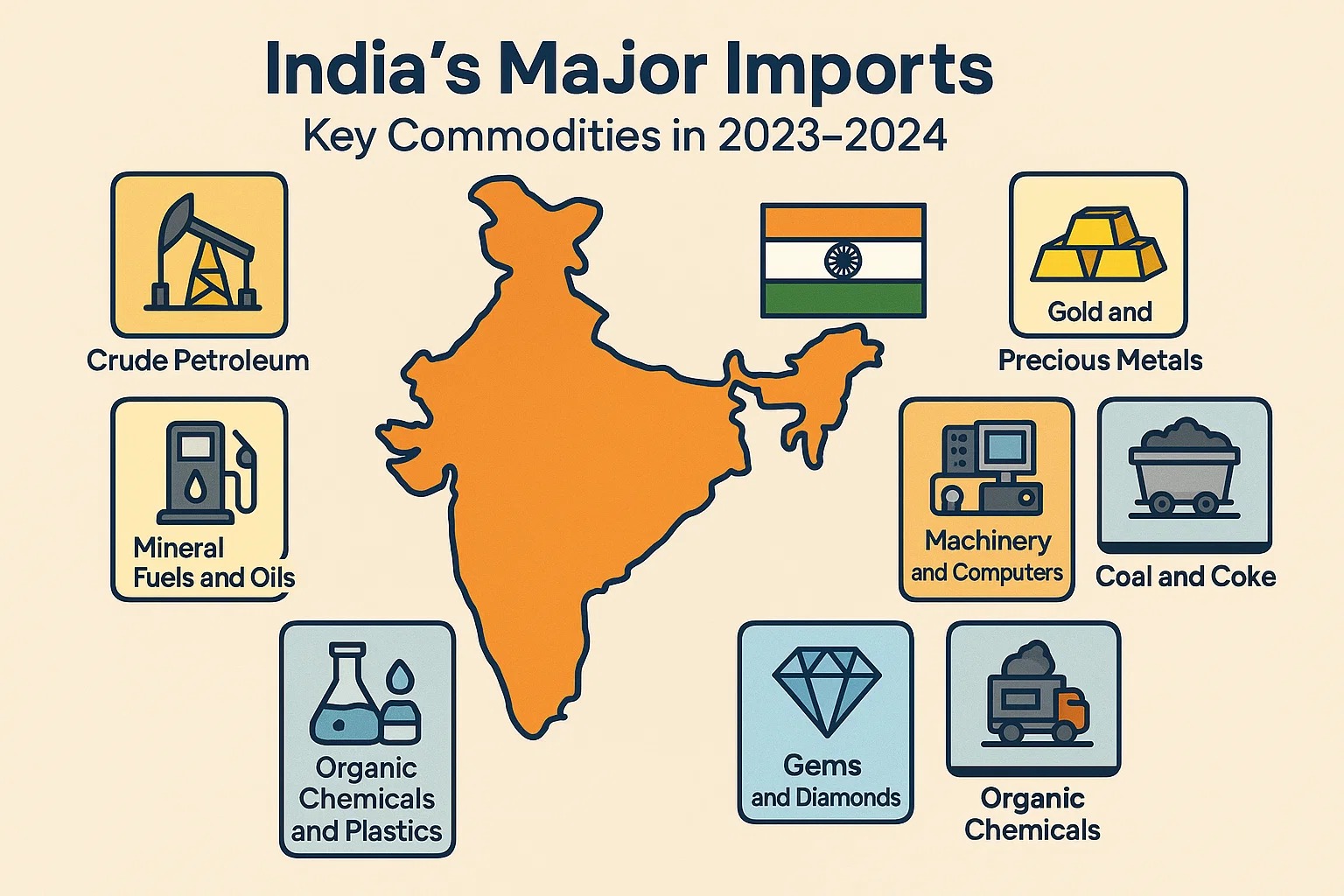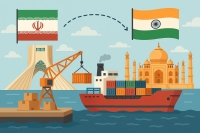Introduction: Iran-India Trade Relations
The bilateral trade relationship between India and Iran has long been a cornerstone of economic cooperation in the region, driven by historical ties, strategic geography, and mutual interests in energy and commodities. Despite global challenges such as international sanctions on Iran, the two nations continue to prioritize trade as a means to enhance connectivity and economic resilience. In recent years, India has emerged as one of Iran's top five trading partners, with bilateral trade reflecting a mix of agricultural exports from India and resource-based imports from Iran, with Shipping from Iran to India serving as a vital link in this exchange.
As of fiscal year 2022-23, the total bilateral trade volume stood at approximately US$2.33 billion, marking a 21.76% year-on-year growth (indianembassytehran). Key Indian exports to Iran include basmati rice, tea, sugar, pharmaceuticals, fresh fruits, and pulses, which cater to Iran's domestic consumption needs. In return, India imports essential commodities from Iran, such as inorganic and organic chemicals, petroleum bitumen, dry fruits like almonds and dates, and liquefied propane.
Main Transportation Routes for Shipping from Iran to India
The shipping from Iran to India is facilitated through diverse transportation routes, including sea, air, and multimodal rail/road networks. This section explores the primary routes for Logistics from Iran to India, focusing on their operational details, advantages, and challenges, with an emphasis on exports from Iran to India.
Sea Freight: Bandar Abbas to Mundra and Nhava Sheva
Sea freight from Iran to India serves as the cornerstone of shipping between the two nations, with key ports like Bandar Abbas, Nhava Sheva, and Mundra acting as vital hubs. Bandar Abbas, Iran’s largest port on the Persian Gulf, handles approximately 85% of Iran’s seaborne trade, making it a pivotal point for exports to India. Goods from Bandar Abbas are transported via Shipping Routes from Iran to Mumbai, primarily to Nhava Sheva (near Mumbai) and Mundra in Gujarat, India’s busiest container ports. Regular services, often managed by a Shipping Company in Iran like the Islamic Republic of Iran Shipping Lines, operate every 10 days, with transit times averaging 7-10 days for direct routes (hindustantimes) For example, shipping a 20-foot container from Bandar Abbas to Nhava Sheva costs approximately US$150-$200, excluding transshipment fees.
The Iran Southern ports Chabahar, developed with Indian investment since 2002, is a strategic alternative for shipping from Iran to India. Located closer to India’s west coast, Chabahar can accommodate ultra-large container ships exceeding 100,000 tons, unlike the congested Bandar Abbas, enhancing the efficiency of the Supply chain Iran India (theallianceshipping)
Air Freight: Expedited Shipments for Urgent Cargo
For urgent or high-value goods, air freight provides a rapid solution for shipping from Iran to India, with transit times of 1-3 days compared to 7-10 days for sea freight (aircgc) Major airports like Tehran’s Imam Khomeini International and India’s Delhi and Mumbai airports facilitate affordable cargo from Iran to India, particularly for perishable items like dry fruits (almonds, dates) and chemicals. Freight forwarder Iran India services, such as those offered by companies like SASCO, streamline customs clearance and documentation. However, air freight costs are significantly higher, ranging from US$2-4 per kg compared to US$0.02-0.05 per kg for sea freight.
Rail and Road Transport via the International North-South Transport Corridor (INSTC)
The International North-South Transport Corridor (INSTC), a 7,200-km multimodal network, enhances shipping from Iran to India by connecting Iran’s ports to India via efficient rail and road routes. Formalized in 2002 by India, Iran, and Russia, the INSTC reduces transit times by up to 40% and costs by 30% compared to the Suez Canal route. For shipments from Iran, cargo departs from Bandar Abbas or Chabahar, moves by road or rail to Iran’s Caspian Sea ports (e.g., Bandar-e-Anzali or Amirabad), and connects to broader networks. Dry runs in 2014 and 2017 showed cost savings of US$2,500 per 15 tons of cargo, with routes like Bandar Abbas to Nhava Sheva taking 18-21 days versus 45-60 days via traditional routes.

India's Major Imports: Key Commodities in 2023-2024
India relies heavily on imports to fuel its industrial, technological, and energy needs. In the fiscal year 2024–25, India’s total imports reached US$915 billion, with fuels and mining products accounting for 33.2%, manufactured goods at 52.1%, agricultural products at 7%, and other goods at 7.7%. If you are an importer in India or planning to export certain products from a third country via Iran to India, the following insights on imports can help guide your sourcing and trade decisions.
- Crude Petroleum: Accounting for about 21% of total imports, valued at over US$10.5 billion in recent data. This is essential for India's refining sector and energy security.
- Mineral Fuels and Oils (including Petroleum Products): Valued at around US$3.27 billion, these include refined products like diesel and gasoline, critical for transportation and manufacturing.
- Electrical Machinery and Equipment: Including electronics components worth US$3.18 billion, such as telecom parts, smartphones, and laptops, supporting India's booming tech and IT industries.
- Gold and Precious Metals: Representing about 6% of imports, with a value of around US$55.8 billion for gold and finished items, driven by jewelry demand and investment.
- Machinery and Computers: Encompassing industrial machinery and computer hardware, vital for manufacturing and infrastructure development.
- Coal and Coke: Used in power generation and steel production, forming a significant portion of energy imports.
- Organic Chemicals and Plastics: Key industrial inputs for pharmaceuticals, textiles, and plastics manufacturing.
- Gems and Diamonds: Imported for cutting and polishing in India's gem industry.
Other notable imports include iron and steel, animal/vegetable fats, and cereals. These commodities highlight India's strategic focus on energy security and technological advancement, with major suppliers like China, Russia, and the UAE.

Key Advantages of Shipping from Iran to India
Countries such as Russia, Kazakhstan, Uzbekistan, Turkmenistan, Azerbaijan, and Armenia increasingly utilize Iran as a strategic transit hub for shipping from Iran to India, leveraging the International North-South Transport Corridor (INSTC) and Chabahar Port. This route enables efficient access to India's vast market, bypassing traditional paths like the Suez Canal or Pakistan, and supports growing trade volumes in commodities like coal, grains, and machinery. Below are essential, practical points for these nations based on current logistics developments.
1.Reduced Transit Time and Cost Savings
The INSTC cuts delivery times from 45-60 days (via Suez) to 18-25 days for cargo from Russia or Central Asia to India, with costs dropping by 30-40%. For example, Russian coal shipments to India via Iran's Bandar Abbas or Chabahar ports can save up to US$2,500 per 15-ton container, making it ideal for bulk exports.
2.Strategic Bypass of Geopolitical Barriers
Landlocked Central Asian countries like Kazakhstan and Uzbekistan benefit from Iran's connectivity to bypass Pakistan, enabling direct access to Indian ports like Mumbai and Nhava Sheva. The Eastern INSTC route (Russia-Kazakhstan-Turkmenistan-Iran-India) has seen cargo volumes rise 19% to 26.9 million tons in 2024, facilitating trade with South Asia.
3.Enhanced Infrastructure and Multimodal Options
Chabahar Port, with India's US$120 million investment in 2024, handles up to 12.5 million tons annually and supports rail-road-sea integration. This allows seamless transit for Afghan and Central Asian goods to India, with ongoing Rasht-Astara railway completion by 2027 improving the Western route (Russia-Azerbaijan-Iran-India).
4.Diverse Cargo Opportunities
Russia plans expanded coal and fertilizer exports to India via INSTC, while Uzbekistan's trilateral efforts with Iran and India focus on seamless connectivity for textiles and minerals. Sanctions on Iran are mitigated through neutral transit agreements, ensuring reliable shipping from Iran to India for non-oil goods.
Projections indicate INSTC cargo reaching 30 million tons by 2030, generating US$1.5 billion in revenues for Iran as a transit hub. Countries should prioritize customs harmonization under TIR conventions and digital tracking to maximize efficiency, especially amid global supply chain shifts.
These advantages position Iran as a vital bridge, fostering economic ties for transit nations with India's US$654 billion import market.
For more information read Cost-Effective Cargo Transit via Iran: Full Guide and Overview of Freight Forwarding in Iran.
Logistics Services and Freight Forwarders
Shipping from Iran to India relies on robust logistics services to ensure efficient trade across the supply chain Iran India. These services encompass sea freight Iran to India, air freight, and multimodal transport, handling cargo like petroleum products and agricultural goods. Key operations include customs clearance, warehousing, and door-to-door delivery, primarily through ports Iran India (Bandar Abbas, Nhava Sheva, Mundra). Freight forwarder Iran India providers navigate challenges like sanctions and customs regulations, ensuring seamless logistics from Iran to India and affordable cargo from Iran to India.
SASCO, based in Tehran since 2015, is a notable provider of these services, offering vessel agency and customs solutions for shipping routes from Iran to Mumbai and shipping from Iran to India.
References
- Federation of Freight Forwarders’ Associations in India (FFFAI), 2014 Dry Run Report.
- Hindustan Times, “Iranian shipping firms eye regular service to Indian ports,” 2022.
- The Wire, “The Political Economics of the International North-South Transport Corridor,” 2022.
- Chanakya Forum, “International North-South Transport Corridor,” 2025.
- Indian Council of World Affairs, “North-South Corridor Brings Central Asia, Europe Closer to India,” undated.







